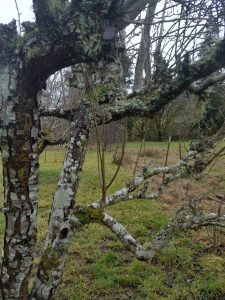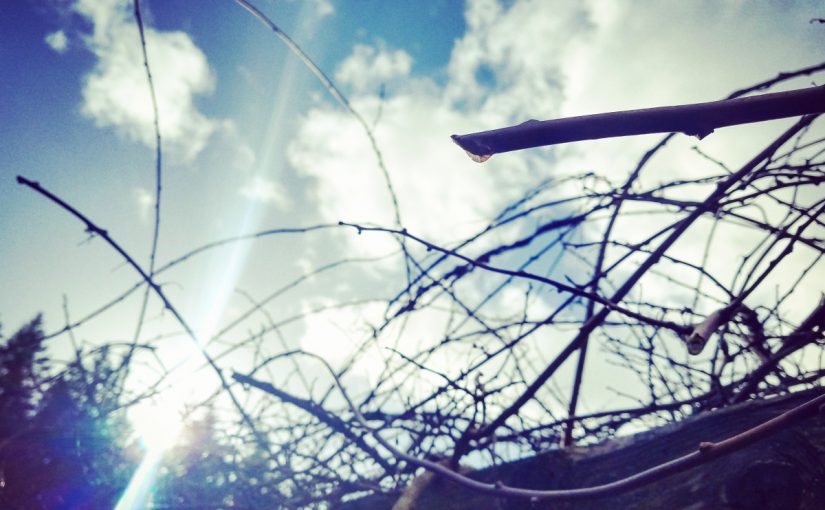Several of the hardy kiwi plants at the Organic Farm are of unknown age, but they are likely to be at least 10 years old.
Category: practicum
Pruning fruit trees
Our little farm came complete with a small fruit orchard; we have several varieties of apples, a few pears, quince, and two varieties of figs. When we purchased this property in November of 2016, much of it (including the orchard) was overrun with blackberries and entirely neglected. As a result, our fruit trees are infested with what is likely Anthracnose (a disease caused by the fungus Neofabraea malicorticis) and horrendously overgrown. The following entry describes my methodology for pruning our apple trees back into good form and good health.
There are two main types of pruning cuts- “heading” cuts and “thinning” cuts. Thinning cuts are exactly what they sound like- removing branches from the tree in order to thin it out. The purpose of thinning cuts is to facilitate good

sunlight penetration into the canopy of the tree and good air circulation within it in order to help combat diseases and rot. Thinning cuts are generally made when the tree is dormant in the winter. Heading cuts are typically utilized in the early summer, and are used to bring the overall width and height of a tree back down to a manageable size and to encourage branching out.
Thinning Cuts, Step 1: Take a step back and look at the whole tree and make a plan. Note where the sunlight hits the tree and which branches prevent sunlight penetration. Observe if there are any suckers, watersprouts, dead or diseased wood, or branches that cross- all of this will need to be removed, but be careful not to remove more than 30% of a tree in a year.

Thinning Cuts, Step 2: Remove suckers at the base of the trunk and cut back as low as you are able. Remove watersprouts, making sure to leave an angled cut so as not to encourage standing water, which can induce rot and disease. Take out any branches that cross or overlap. Cut back any dead or diseased wood and burn any diseased wood after it is removed.
In late spring or early summer, heading cuts may be utilized. Heading cuts can further reduce shade within the tree, allowing more sunlight penetration and air circulation. Heading cuts can also bring down the overall height of the tree and the overall spread, making the tree much more manageable from the ground.
Our poor trees will take several years to get back into good shape, so patience is a must when dealing with overgrown trees! This winter I removed many watersprouts and diseased branches (and even whole limbs), and come Spring I will utilize some heading cuts to bring down the overall height of our orchard.
The ultimate goal in pruning is to achieve trees that are healthy, productive, and manageable- left alone (as are trees have been), fruit trees will grow wild and produce sub-par fruit that is difficult to harvest. We found this out the hard way this past summer! I am looking forward to this summer’s growing season to see the difference my pruning has made in our fruit.
